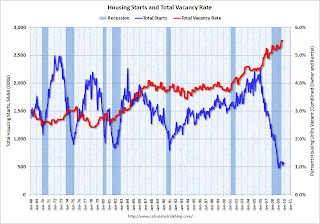by Calculated Risk on 1/20/2010 06:13:00 PM
Wednesday, January 20, 2010
Housing Starts, Vacant Units and the Unemployment Rate
The following two graphs are updates from previous posts with the housing start data released this morning.
The following graph shows total housing starts and the percent vacant housing units (owner and rental) in the U.S. Note: this is a combined vacancy rate based on the Census Bureau vacancy rates for owner occupied and rental housing through Q3 2009 (Q4 will be released in early February). Click on graph for larger image in new window.
Click on graph for larger image in new window.
It is very unlikely that there will be a strong rebound in housing starts with a record number of vacant housing units.
The vacancy rate has continued to climb even after housing starts fell off a cliff. Initially this was because of a significant number of completions. Also some hidden inventory (like some 2nd homes) have become available for sale or for rent, and lately some households have probably doubled up because of tough economic times. The second graph shows single family housing starts and unemployment (inverted). (The first graph shows total housing starts)
The second graph shows single family housing starts and unemployment (inverted). (The first graph shows total housing starts)
You can see both the correlation and the lag. The lag is usually about 12 to 18 months, with peak correlation at a lag of 16 months for single unit starts. The 2001 recession was a business investment led recession, and the pattern didn't hold.
This suggests unemployment might peak in Summer 2010 since housing starts bottomed in April 2009. However, since I expect the housing recovery to be sluggish, I also expect unemployment to remain high throughout 2010 (I think double digits throughout 2010 is very likely without additional job related stimulus).
Until the large overhang of vacant housing is reduced, a significant rebound in housing starts is also very unlikely.


